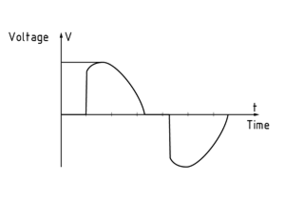
Seleccione uno
o más idiomas
0,1,3
- Alemán
- Inglés
- Chino
- Español
Phase control (electrical engineering)

Phase control or phase-angle control is a method applied in Power electronics to regulate the power of electrical consumers and consumers operated with alternating voltage. Only parts of the alternating voltage are used to generate power.
Controllable semi-Conductor elements are required for phase control. Also referred to as valves, these elements receive a delayed ignition signal after the natural commutation and become conductive in that moment. The longer the delay that can be set, the lower the available rms output voltage and, accordingly, the lower the power emitted.
The opposite of phase control is reverse phase control. In this case, the natural ignition moment remains the same but the valve is switched off prior to commutation.
Since phase control benefits from low energy losses, it is used for applications in the field of power engineering. Current and voltage are not sinusoidal, which results in distortive Reactive power.
